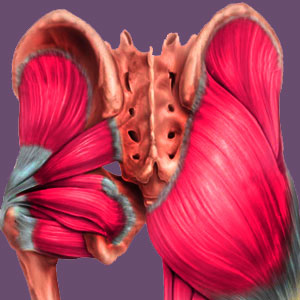
What is the pelvic clock exercise for piriformis pain and how well does it work? Although having lots of hype surrounding it, the pelvic clock exercise is not some miracle cure for piriformis syndrome and rarely actually addresses the most common causes of piriformis compression of the sciatic nerve, despite claims to the contrary.
We are outspoken advocates of exercise therapy and would love to see more patients with chronic musculoskeletal issues embracing this holistic way of treating pain. However, we also are realistic in our evaluation of the pelvic clock exercise and felt compelled to detail its strong and weak points for the benefit of our readership.
This short, simple essay will evaluate the pelvic clock exercise when used as a dedicated treatment for piriformis syndrome. We will explore the pros and cons of the pelvic clock and allow patients to decide for themselves if the exercise is worthwhile for their particular case profile.
Description of Pelvic Clock Exercise for Piriformis Pain
Ok, let’s put you in position to perform the exercise in order to explain it to you… Lie down on a comfortable surface that will not cause pressure against your back. Pull your knees up and in, with your feet on the floor, bending your knees to an angle of approximately 90 degrees. Relax your body and imagine a clock sitting on your abdomen, with the 12:00 point at the top and the 6:00 point at the bottom. This will also place the 9:00 point at your right side, while the 3:00 point will be at your left. Imagine the clock to be about 1 foot or 30 cm in diameter…
The idea of the pelvic clock is to mobilize the pelvis and surrounding tissues in various ways using the points of the clock as guidance. Typically, you will begin by rocking the pelvis up and down, bringing the pelvis upwards towards 12:00, then downwards to 6:00 using a gentle motion. Next, you will bring the pelvis side to side starting at 9:00 and crossing to 3:00. Finally, you will go in circles around the clock, using both clockwise and counterclockwise directions. This is the traditional pelvic clock in 3 parts. However, virtually any combination of movements can be utilized, including marking all the clock points or connecting them randomly or in set patterns.
Pelvic Clock Pros
The pelvic clock exercise is designed to work the tissues of the lower body with both stretching and exercise practices. It is a gentle exercise and not overly strenuous, being nonimpact and not traumatic in any way.
Proponents of the exercise report that it can correct pelvic shifts, misalignments and tilts. It can stretch and strengthen core muscles, as well as many of the muscles which surround to the pelvis, sacrum, hip and lower spine.
The exercise is claimed to have widespread benefits for patients with a variety of painful conditions affecting the hips, pelvis, lower back, sacroiliac joint and others tissues. It is certainly not limited to treating piriformis syndrome.
If the piriformis is indeed spasming because of some rare muscular issue, such as a pelvic tilt or imbalance, then the pelvic clock might just provide a true cure without risk.
Pelvic Clock Exercise for Piriformis Cons
Unfortunately, most piriformis pain is not due to any condition that will resolve using the pelvic clock, which explains why so many patients find the exercise to help them slightly in the short term, but fails them completely in the long-term.
While the exercise is certainly beneficial to health and general physical condition and is definitely not harmful in any way, it is rarely a cure for piriformis syndrome. We found very few cases where the pelvic clock or any exercise program resolved chronic piriformis pain, with the exception being cases caused by known injury. In these circumstances, the injury would heal with time alone, but rehabilitative therapy including exercises like the pelvic clock are obviously beneficial and speed things along…
We have discovered that exercise therapy is a major source of substitute symptoms in piriformis patients who are suffering from ischemia, since the treatment tends to perpetuate the suffering, rather than resolve it. This was first discovered by the world famous Dr. John Sarno in the 1970s and still holds true today, explaining why the countless millions of people with oxygen deprivation pain syndromes tend to get worse with treatment, rather than improve…
If known injury or pelvic issues are the verified cause of piriformis pain, then exercises just like the pelvic clock might be optimal. However, in most other case profiles, the treatment will likely disappoint, being that it is probably not going to target the actual mechanism for pain.
Piriformis Pain > Piriformis Exercises > Pelvic Clock Exercise for Piriformis





